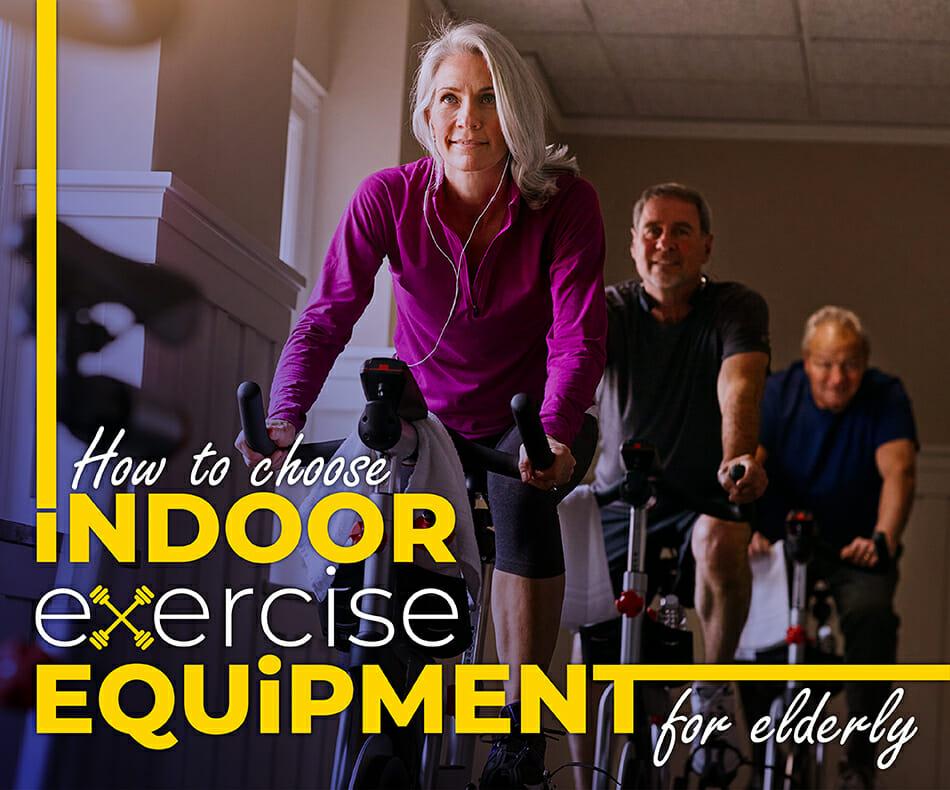Regular physical activity is essential for maintaining a healthy lifestyle, especially for seniors. However, only some people are comfortable going to the gym or exercising outdoors, especially during extreme weather conditions. Indoor exercise equipment provides a convenient and safe way for seniors to stay active and healthy without leaving the comfort of their homes. Choosing the right indoor exercise equipment for elderly individuals can be challenging, given their unique needs and limitations.
Considerations for Choosing Indoor Exercise Equipment for Elderly
It’s more crucial than ever to stay healthy and active as we age. Regular exercise is essential to a senior’s healthy lifestyle, which may be accomplished with indoor exercise equipment. There are several crucial things to consider while selecting indoor workout equipment for elderly adults.
A. Health Condition
Before purchasing exercise equipment, it is vital to consider the older adult’s health condition. Any pre-existing medical conditions or limitations should be considered, and the equipment chosen should be safe and appropriate for their specific health needs.
B. Physical Capabilities
The physical capabilities of the older person should also be considered when choosing indoor exercise equipment. Choosing equipment that is easy and safe to use and matches their physical abilities is important. For example, if the older adult has limited mobility, a treadmill or elliptical may not be the best choice.
C. Space Availability
The amount of space available for the exercise equipment is another important consideration. Some types of equipment, such as treadmills or weight machines, require more space than others, such as resistance bands or yoga mats. Choosing equipment that fits comfortably in the available space and does not create any safety hazards is important.
D. Security Measures
When selecting indoor exercise equipment for the elderly, safety aspects are still another crucial factor.
E. Budget
The cost of the equipment is another important consideration. Indoor exercise equipment can range from very affordable to very expensive. It is important to set a budget before beginning the search for equipment and to choose equipment that fits within that budget.
F. Ease of Use
The equipment chosen should also be easy to use. The older adult should be able to operate the equipment without difficulty, and the equipment should not require complex or confusing instructions. This can guarantee that the equipment is utilized frequently and that the older person is able to get the full rewards of regular exercise.
G. Maintenance
The maintenance requirements of the equipment should be considered. Equipment that requires regular maintenance or repairs may not be the best choice for the elderly, as they may not be able to perform these tasks themselves. It is important to choose equipment that is durable and easy to maintain.
What type of exercise equipment is best for seniors?
A. Stationary Bikes:
Choose a bike with a comfortable seat and adjustable resistance. Look for safety features like handrails and non-slip pedals.
B. Ellipticals:
Choose an elliptical with adjustable resistance and a comfortable stride length. Look for safety features like handrails and non-slip pedals.
C. Treadmills:
Choose a treadmill with a low starting speed and adjustable incline. Look for safety features like handrails and a key that stops the machine if the user falls.
D. Resistance Bands:
Choose resistance bands with varying levels of resistance. Look for crews with comfortable handles and a non-slip surface.
E. Weight Machines:
Weight machines are famous strength training equipment for building muscle and improving bone density. As we age, our muscle mass and bone density naturally decrease, making weight machines a valuable tool for seniors to maintain their physical health.
When selecting weight machines for seniors, it’s essential to consider their physical capabilities and any preexisting health conditions. Low-impact machines, such as leg and chest presses, are great options for seniors with joint pain or difficulty with high-impact exercises.
Why Do Seniors Need Exercise?
As people age, they become more susceptible to health issues like heart disease, diabetes, and osteoporosis, which can be prevented or managed through regular exercise.
Here are some specific reasons why seniors need exercise:
Maintain a Healthy Weight: As people age, their metabolism slows down, and they may find it more challenging to maintain a healthy weight. Regular exercise can help seniors burn calories, maintain muscle mass, and stay fit.
Improve Balance and Coordination: Falls are a common problem for seniors and can lead to severe injuries. Exercise focusing on balance and coordination, such as yoga or tai chi, can help reduce the risk of falls and improve overall mobility.
Increase Strength and Flexibility: As people age, they may experience muscle loss and decreased flexibility, making daily tasks more difficult. Exercise focusing on strength training and stretching can help seniors maintain muscle mass and improve flexibility.
Reduce the Risk of Chronic Health Conditions: Regular exercise can help reduce the risk of chronic health conditions such as heart disease, diabetes, and osteoporosis. Exercise helps lower blood pressure, reduce inflammation, and control blood sugar.
Boost Mood and Mental Health: Exercise has been shown to boost mood and improve mental health, which is especially important for seniors dealing with losing a spouse, retirement, or other life changes.
Final thoughts
Regular exercise is essential for maintaining good health and well-being, especially in seniors. Investing in an inner exercise outfit can be a great way to help seniors stay active and healthy while staying safe indoors. Still, it’s essential to choose the right outfit suitable for their health condition, physical capabilities, and space. Seniors can consult with their healthcare provider or a Pukka fitness professional to help them make informed opinions.
